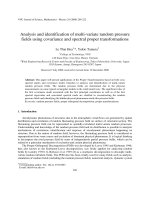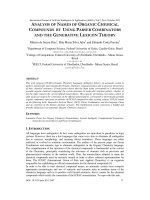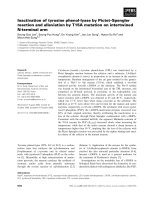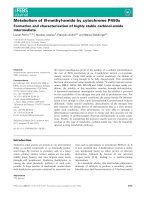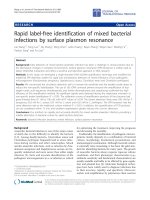Identification of middle ear effusion by aural acoustic admittance and otoscopy có NC DÙNG NLD để xđ VTGTD
Bạn đang xem bản rút gọn của tài liệu. Xem và tải ngay bản đầy đủ của tài liệu tại đây (41.71 KB, 2 trang )
/>Ear Hear. 1994 Aug;15(4):310-23.
Identification of middle ear effusion by aural
(thuộc về tai, thính giác) acoustic (thuộc về
âm thanh, thanh học) admittance and
otoscopy.
Nozza RJ, Bluestone CD, Kardatzke D, Bachman R.Source: Children's
Hospital of Pittsburgh.
Abstract
The ability of aural acoustic immittance measures and validated ngoại
động từ - làm cho có giá trị, làm cho có hiệu lực, làm cho hợp lệ; phê chuẩn pneumatic
otoscopy to identify middle ear effusion (MEE) was determined for a
group of children with chronic or recurrent otitis media. The measures
were made immediately prior to surgery for placement of tympanostomy
tubes, with the validating diagnosis of MEE made by the surgeons. Aural
acoustic admittance measures were made by a certified and licensed
clinical audiologist using an instrument that meets current standards and
otoscopic examinations were made by a nurse practitioner validated for
use of otoscopy in the identification of MEE. Logistic regression
analyses were done to determine the ability of admittance variables,
otoscopy, and their combination to discriminate between ears with and
ears without MEE. Of the individual admittance variables,
tympanometric width had the best performance. Otoscopy alone had
good sensitivity but only fair specificity. Combining acoustic admittance
data with the otoscopist's findings did not improve sensitivity greatly,
but improved the specificity relative to that of the otoscopist. The
criterion tympanometric width > 150 daPa or Ytm < 0.2, a criterion tiêu
chuẩn commonly used based on interim norms published in an appendix
of ASHA guidelines for screening, had good sensitivity but very poor
specificity in the group of children scheduled for surgery. Also, a
comparison was made for tympanometric width measures from the
children undergoing surgery with those from a group of children more
representative miêu tả, biểu hiện - tiêu biểu, tượng trưng; đại diện of the general
population. Three distributions were found; one for ears with MEE, one
for ears with no MEE of children scheduled for otologic surgery and one
for ears with no MEE from the group of children from the general
population. The data illustrate the importance of the population
characteristics on the test measure used and have implications for
choosing test criteria. In addition, group estimates of performance of
acoustic admittance variables were approximately the same when
otoscopy was used as the gold standard for identification of MEE as
when findings at surgery were used. However, when comparing the two
diagnostic methods on a case-by-case basis, it was determined that the
otoscopist's diagnosis disagreed with the diagnosis of the surgeons in
over 21% of the ears.



